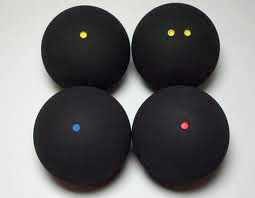What is the difference between squash balls?
Squash balls for senior players come in six varieties, each with different levels of ‘bounce’. The level of bounce is denoted by coloured dots on the ball. For younger players, there are a number of ‘Mini-Squash’ balls available which have a very high, prolonged bounce.
Colour |
Bounce |
Speed (hang time) |
Suggested player level |
| Orange | Super low | Super low | High altitude play |
| Double yellow | Slow | Very low | Experienced squash players |
| Yellow | Slow | Low | Advanced |
| Green | Medium/slow | Average | Advanced |
| Red | Medium | High | Beginners |
| Blue | Fast | Very high | Juniors and new players |
* please note: the colours can vary depending on the brand, so make sure you check when purchasing. Also, please feel free to ask us any questions in the comments below.
The standard ball for professional competitions is the double yellow according to the World Squash Federation. This has been the case since 2001. The bounce of a squash ball also varies as a function of temperature, which is why it is recommended that a squash ball is warmed up before use.
Before 2001, the single yellow dot ball was the competition standard.

How to choose a squash ball
The four most common kinds of squash balls are red, blue, single yellow and double yellow. When starting out blue or red balls are best (unless as previously mentioned it is a very young player, in which case ‘Mini-Squash’ balls are preferable, with the orange one being the best). These allow for players who are still developing their hand-eye-coordination to learn techniques without slow reaction times halting progress. Some manufacturers also offer slightly larger balls for new players – for instance the Dunlop ‘Intro’ ball is 12% larger than the standard size, making the ball slower.
Unless you are a good player it is best to play with a blue or red ball while you improve, as more advanced balls require long rallies and regular hard hitting in order to stay sufficiently warm.

As you get better at squash you can move on to single yellow dot balls, but don’t be tempted to move to double yellow balls immediately. Playing with a more difficult ball prematurely can hinder your performance. Hitting a boast shot for instance, is easier with a single dot ball as the ball sits up a bit higher. Double yellow squash balls are typically used by advanced players.
If you are playing against someone who is at a lowel level than you, play with a ball that is appropriate for his/her skill level.
The temperature of the court should also be taken into account, as some courts are colder than others and you will therefore find it easier to play with bouncier balls. In the winter on colder courts, we frequently use single dot balls even for advanced players, as the double dot balls simply don’t bounce enough. It often simply makes for a far more enjoyable game to avoid the double dot.
The altitude of a court should also influence your ball choice. In high altitude areas with lower air pressure, it is necessary to use a ball that has even less bounce. A high altitude ‘orange dot ball’ is often used in places such as Mexico City, Johannesburg and Calgary, while a ‘Dunlop green dot’ ball is commonly used in North America.
Using different squash balls in training
There is a bit of egotism in using a double dot ball but there really shouldn’t be at all. It’s a great training exercise to use different balls, especially for advanced players. If you want to focus on volleying, it can be a great exercise to use a much bouncier single dot ball to test an advanced player’s reactions, as the ball will rebound off of the front wall faster. You’d be amazed as well at how difficult it can be to control a very hot single dot or red dot ball when hitting length or short shots. It’s a great ball control exercise to get players seeing if they can still hit dying lengths – length shots which don’t come out of the back corners – with a single or red dot ball. Equally, if you want to work on finishing rallies or hitting better drop shots, use bouncier balls. Anyone can learn to hit a drop shot with a lukewarm double dot ball but can you hit a winning drop – or indeed any winning shot – with a piping hot red dot ball?
Happy playing! If you have any questions or further insights feel free to leave a comment below.
For more information about what equipment to use, we also have detailed guides on rackets and strings.